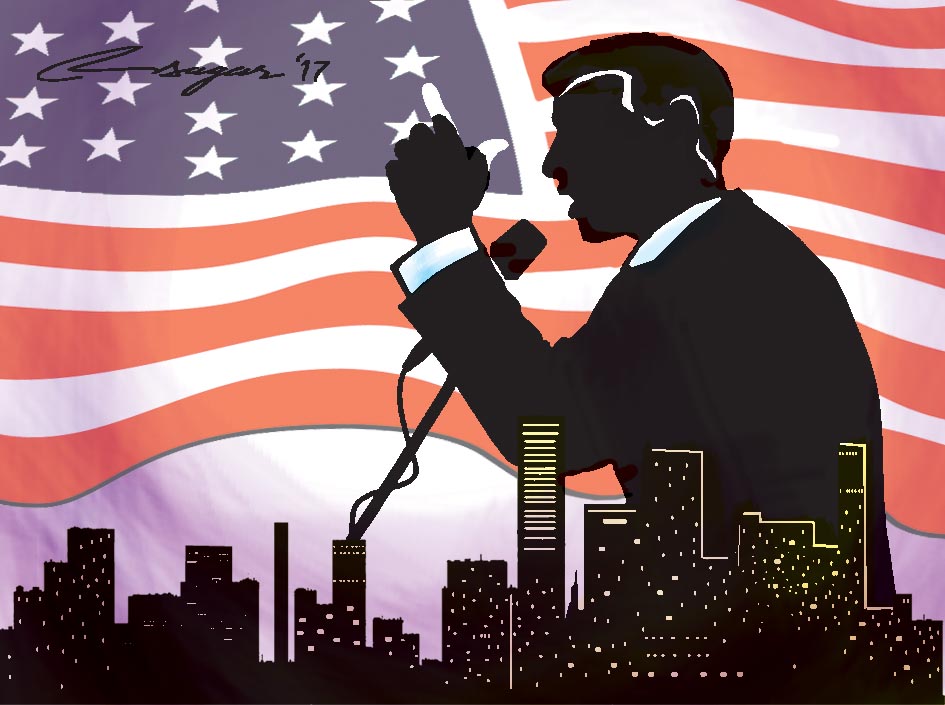Populist plutocracy: The future of America
In the first year of his presidency, Donald Trump has consistently sold out the blue-collar, socially conservative whites who brought him to power, while pursuing policies to enrich his fellow plutocrats
Donald Trump won the US presidency with the backing of working-class and socially conservative white voters on a populist platform of economic nationalism. Trump rejected the Republican Party’s traditional pro-business, pro-trade agenda, and, like Bernie Sanders on the left, appealed to Americans who have been harmed by disruptive technologies and “globalist” policies promoting free trade and migration.
But while Trump ran as a populist, he has governed as a plutocrat, most recently by endorsing the discredited supply-side theory of taxation that most Republicans still cling to. Trump also ran as someone who would “drain the swamp” in Washington, DC, and on Wall Street. Yet he has stacked his administration with billionaires (not just millionaires) and Goldman Sachs alumni, while letting the swamp of business lobbyists rise higher than ever.
Trump and the Republicans’ plan to repeal the 2010 Affordable Care Act (Obamacare) would have left 24 million Americans – mostly poor or middle class, many of whom voted for him – without health care. His deregulatory policies are blatantly biased against workers and unions.
Trump has also abandoned his base in the area of trade, where he has offered rhetoric but not concrete action. Yes, he scrapped the Trans-Pacific Partnership (TPP), but Hillary Clinton would have done the same. He has mused about abandoning the North American Free Trade Act (NAFTA), but that may be just a negotiating tactic. He has threatened to impose a 50% tariff on goods from China, Mexico, and other US trade partners, but no such measures have materialized. And proposals for a border adjustment taxhave been all but forgotten.
Trump’s bullying tweets against US firms that move production offshore or undertake tax inversions have been no more than cheap talk, and business leaders know it. Manufacturers who fooled Trump into thinking they would keep production in the US have continued to transfer operations quietly to Mexico, China, and elsewhere.
Moreover, international provisions in the pending tax legislation will give US multinationals an even greater incentive to invest, hire, and produce abroad, while using transfer pricing and other schemes to salt away profits in low-tax jurisdictions.
Likewise, despite Trump’s aggressive rhetoric on immigration, his policies have been relatively moderate, perhaps because many of the businesspeople who supported his campaign actually favor a milder approach. The “Muslim ban” doesn’t affect the supply of labor in the US. Although deportations have accelerated under Trump, it’s worth remembering that millions of undocumented immigrants were deported under Barack Obama, too. The border wall that Trump was going to force Mexico to pay for remains an unfunded dream. And even the administration’s plan to favor skilled over unskilled workers will not necessarily reduce the number of legal migrants in the country.
All told, Trump has governed like a plutocrat in populist clothes – that is, a pluto-populist. But why has his base let him get away with pursuing policies that mostly hurt them? According to one view, he is betting that social conservatives and white blue-collar supporters in rural areas will vote on the basis of nationalist and religious sentiment and antipathy toward secular coastal elites, rather than for their own financial interests.
The tax legislation that Republicans have rushed through Congress could prove especially dangerous, given that millions of middle-class and low-income households will not only get little out of it, but will actually pay more when income-tax cuts are phased out over time.
Nevertheless, Trump and the Republicans seem willing to risk it. Another part of the Republican strategy (known as “starve the beast”) will be to use the higher deficits from tax cuts to argue for cuts in so-called entitlement spending, such as Medicare, Medicaid, food stamps, and Social Security. Again, this is a risky proposition, given that elderly, middle-class, and low-income Americans rely heavily on these programs.
With the global economy expanding, Trump is probably hoping that tax cuts and deregulation will spur enough growth and create enough jobs that he will have something to brag about. A potential growth rate of 2% won’t necessarily do much to help his blue-collar base, but at least it could push the stock market up to its highest point ever.
Whatever happens, Trump will continue to tweet maniacally, promote fake-news stories, and boast about the “biggest and best” economy ever. In doing so, he may even create a circus worthy of a Roman emperor.
But if gassy rhetoric alone does not suffice, he may decide to go on the offensive, particularly in the international sphere. That could mean truly withdrawing from NAFTA, taking trade action against China and other trading partners, or doubling down on harsh immigration policies.
And if these measures do not satisfy his base, Trump will still have one last option, long used by Roman emperors and other assorted dictators during times of domestic difficulty. Namely, he can try to “wag the dog,” by fabricating an external threat or embarking on foreign military adventures to distract his supporters from what he and congressional Republicans have been doing.
Project Syndicate






